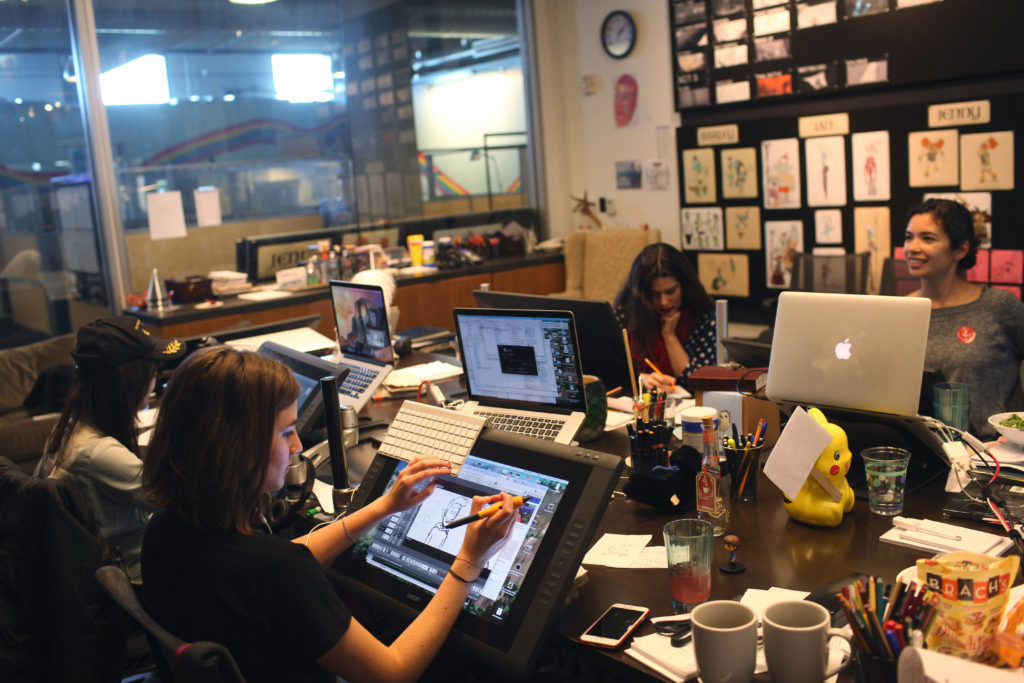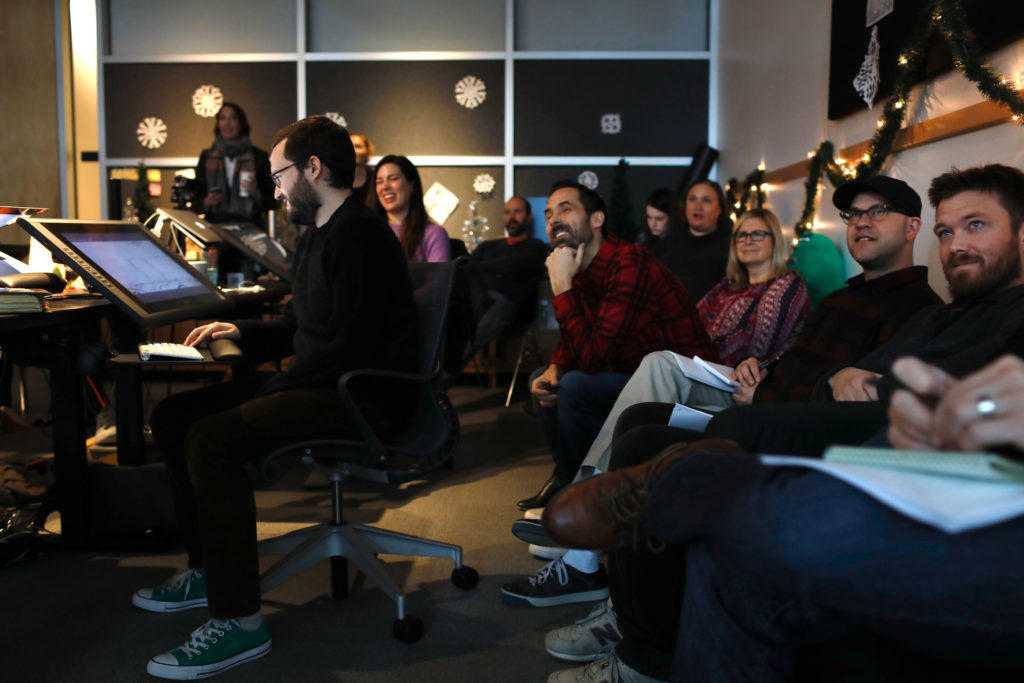
Born and raised in Southern California, Catalina is a freelance…
BGN was fortunate enough to visit Pixar Studios in Emeryville, California, where we got an inside look at the upcoming animated film, Onward.
It is Pixar’s first magic-centered film, and they are beyond proud of it. During our time with Pixar talent, we got to chat with a few of the people responsible for the film, including director Dan Scanlon, producer Kori Rae, head of story Kelsey Mann, and story lead Madeline Sharafian. They gave us a glimpse behind the curtain of what it takes to make an animated film — from script to storyboard.

Dan Scanlon (Photo by Deborah Coleman / Pixar) 
Kori Rae (Photo by Deborah Coleman / Pixar) 
Kelsey Mann (Photo by Deborah Coleman / Pixar) 
Madeline Sharafian (Photo by Deborah Coleman / Pixar)
Disney and Pixar’s Onward introduces us to two elf brothers who embark on an epic quest to discover if there is still magic left in the world. The film is filled with elves, sprites, satyrs, cyclops, centaurs, gnomes, and trolls, among other creatures from mythology, folklore, fables, and fantasy fiction. “It’s a modern suburban fantasy film — a new genre for Pixar,” said producer Kori Rae. “The story is inspired by my own relationship with my brother and our connection with our dad who passed away when I was about a year old,” says director Scanlon. “He’s always been a mystery to us. A family member sent us a tape recording of him saying just two words: ‘hello’ and ‘goodbye.’ Two words. But to my brother and me — it was magic.”
“That was the jumping-off point,” continues Scanlon. “We’ve all lost someone, and if we could spend one more day with them — what an exciting opportunity that would be. We knew that if we wanted to tell that story that we’d have to set the movie in a world where you could have that incredible opportunity.”

Cue the talented team responsible for storyboarding and pitching to Scanlon, trying to capture his vision. The hard part was coming up with a story that is compelling and good. It was amazing to see just how much goes into bringing a Pixar film to the big screen.
Mann’s job, in a nutshell, is to assist the storyboard artists. He and the team assist the director, writer, and producer in telling a compelling and moving story through visuals. They basically draw the movie from start to end. Sharafian does all the same stuff as a normal storyboard artist, all the drawings and everything, but also helps Mann if he gets too busy. She checks the artist’s work and helps edit, and she was also part of the script-writing process for this film.
Mann was on the team from day one, which is a little different. Scanlon and Mann both worked on Monsters University, which was also directed Scanlon. Rae was the producer on both films as well. After Monsters University, Scanlon had the opportunity to do his own film that was an original. They spend so much time on these films to not just make them good, but great. On day one, it was Scanlon coming up with the type of movie he wanted to make.

An Onward story review, as seen on December 14, 2018 at Pixar Animation Studios in Emeryville, Calif. (Photo by Deborah Coleman / Pixar) 
Onward story team members work in the “fishbowl,” a common work space for everyone to be together while working, as seen on November 8, 2016 at Pixar Animation Studios in Emeryville, Calif. (Photo by Deborah Coleman / Pixar)
Two locations that helped the team organize their thoughts and direction were the “Fishbowl” and the “Story Room.” The Fishbowl is full of artists drawing scenes and characters from Onward. The Story Room is where the script was developed.
It’s no easy feat getting through those first drafts of script. The words go through multiple people before landing on the final pages. Scanlon and Jason Headley, another writer on the film, would make a pass through the storyboards.
“If we felt really good about the cards and the sequence, they [Scanlon and Headley] would go off and write it,” says Mann. “They would go back and forth until they were happy with it.”
From their hands, the pages would go to a small group who read it, marked it up, and gave their own thoughts. There would be criticism like, “Oh, I’m not sure about this,” or “I think we should cut this line.” They would go page by page with this process. Sometimes Scanlon agreed and sometimes he didn’t.
“Sometimes we would not do exactly what the idea was, but we do something that would still address it in a different way,” says Mann.
At some point, Sharafian and her team would be given the script and sometimes people would read it at their desk or go anywhere on the gorgeous campus and try to get into the scene, try to read it and try to absorb it and think about it visually.
“We’re transferring it from the written word to a visual medium,” says Sharafian.

The talent is astounding. Quick sketches, thoughts on story, write-ups for character development: it’s all part of the magic of making an animation film. Sometimes, Scanlon acts out what he wants to see on the screen, making the artist’s job much easier. Sharafian explains that there are so many things going through your head as you are off drawing. “You’re boarding and you’re thinking about cinematography, writing, acting, character, staging, editing, humor, composition, and above all, deadline,” she says.
Making an animated film looks like fun but is very hard sometimes. One of the upsides is collaboration. Looking at the collaboration in the room, you see Scanlon with the writers and PAs.
“We don’t have a set. We just have our offices,” says Mann. “So it’s hard to feel like you’re actually making a movie sometimes if you’re off in your office. So, it was fun to walk in here because then you can just feel like, ‘Oh my God, we’re doing something together.’”
When you put all the pieces of the pie together, Onward ended up with 97,759 storyboards, which is a lot of drawing. After they’ve done all the drawings for their section, it’s time to pitch.

“You get the entire story team in the Fishbowl. We try and get edit in there, art in there. Anyone who is seen as going to be directly impacted. Dan and Kori are there, too,” says Sharafian. The scene they shared that embodies this process is titled, “Trust Bridge.” Sharafian pulled up the art, and we got to see a board-by-board reenactment of the scene. She did all the different voices as well.
All I can say is kudos to those pursuing this career. It takes so much and such a long time to get these films off the ground. We are all thoroughly impressed.
We are looking forward to this film. Onward releases in theaters on March 6, 2020.
What's Your Reaction?
Born and raised in Southern California, Catalina is a freelance journalist and film critic. You can also find her work on blackfilm.com and documentary.org. She has moderated and served on film panels, interviewed casts and crews of various films, and has been a juror for the New Orleans Film Festival. Catalina is a member of numerous critics' associations, including the Critics Choice Association, African American Film Critics Association, the Online Association of Female Film Critics, and the Hollywood Creative Alliance, as well as a Rotten Tomatoes-approved critic.













